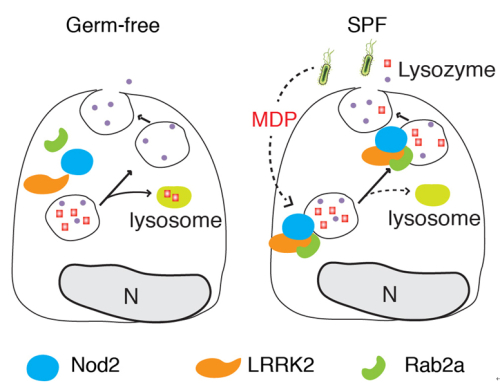A novel insight into the reciprocal interaction between commensal bacteria and host
Intestinal homeostasis depends on proper interactions between the mucosal immune system and intestinal microbiota. The complex nature of the symbiotic interactions between the host and microbes is beginning to be explored. Commensals can alter gene transcription, induce epigenetic modification and promote the differentiation of specific cell lineages. However, many other possible mechanisms of symbiotic interactions remain to be explored.
Mucosal immunity protects a host from intestinal inflammation and infection and is profoundly influenced by symbiotic bacteria. Zhihua Liu lab at the Institute of Biophysics, Chinese Academy of Sciences reported that in mice symbiotic bacteria directed selective cargo sorting in Paneth cells to promote symbiosis through Nod2, a cytosolic bacterial sensor, and the multifunctional protein kinase LRRK2, both encoded by inflammatory bowel disease (IBD)-associated genes. Commensals recruited Nod2 onto lysozyme-containing dense core vesicles (DCVs), which was required for DCV localization of LRRK2 and a small GTPase, Rab2a. Deficiency of Nod2, LRRK2 or Rab2a or depletion of commensals resulted in lysosomal degradation of lysozyme. Thus, commensal bacteria and host factors orchestrate the lysozyme-sorting process to protect the host from enteric infection, implicating Paneth cell dysfunction in IBD pathogenesis.
This study was published online on August 3, 2015 in Nature Immunology entitled “Commensal bacteria direct selective cargo sorting to promote symbiosis”.
Zhihua Liu is the last corresponding author. Qin Zhang, anassociate researcher, and Ying Pan, a research assistant in Liu’s lab are the co-first authors. Ruiqing Yan, Haifang Wang andXinwen Zhang performed experiments in this study. Hong Wei is a co-corresponding author of the paper. Benhua Zeng, Wenxia Li and Hong Wei from Third Military Medical University provided germ-free mice for the research.
This work was supported by the National Natural Science Foundation of China, the National Basic Research Program of China, and the Chinese Academy of Sciences-Novo Nordisk Foundation. Z.Q. was supported by National Science Foundation of China and the Beijing Natural Science Foundation.
Figure. A working model on symbiotic bacteria directing lysozyme sorting in Paneth cells through a molecular pathway including Nod2, LRRK2 and Rab2a.(image by Zhihua Liu et.al)


